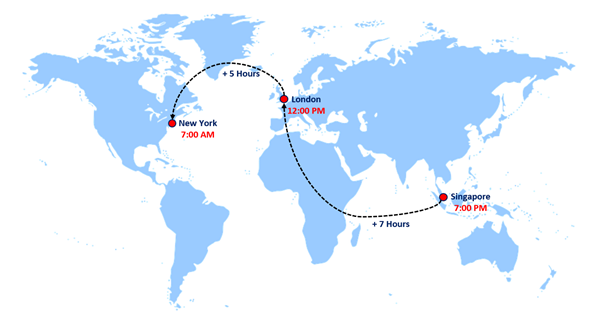Multi-national trading organizations carry out their activities nearly around the clock. To provide local coverage for global markets, these organizations have satellite offices with overlapping workdays. Given the nature of trading, business activities are non-stop. While one office location is starting their day, another is at their mid-day or even preparing to close for the day. Herein lies the challenge: for the office starting their day, it is essential that they get the latest updated numbers from the office that has closed for the day. This is where the responsiveness of the CTRM system comes into the picture and what we will cover in this article.
Organizations run end of day (also known as ‘close of business’) process in their CTRM systems once their local markets have closed. This process typically involves multiple activities. For example: verifying trades, loading the latest prices, generating documents, passing information to downstream systems, etc. Once end of day processes start, they use up heavy processing power and valuable resources from the CTRM system servers. It then becomes essential that these processes are either completed before the next satellite office comes in or the execution time for this end of day or close of business processes is kept at minimum. Alternatively, the needed resources could be allotted for business users to perform their activities in a timely manner.
Consider this example. Assume that an organization has remote offices in Singapore, London, and New York. Disregarding DST, Singapore and London have a time difference of 8 hours, while London and New York have a time difference of 5 hours for most of the year In an ideal situation, the Singapore office finishes their day to run the end of day process at 7 pm local time. Given that the UK office will be in full swing at 11 am, the process needs to finish quickly and efficiently.
If the process is delayed, London users start experiencing performance issues. Further, these issues can have a knock-on effect on the London office’s end of day process that might then only compound, impacting the New York office workday as well.
It is worth stressing that these issues may be quite disruptive, impacting the employee workday and potentially leading to financial losses.

There are ways to greatly decrease the odds of this kind of impact! Below are some key tactics that can get your business in the right working order:
- Run prechecks before running end of day processes (e.g., check if all the prices are available for valuation) – these prechecks make sure that the end of day process runs without data issues and greatly decreases the likelihood of needing to be re-run.
- Decrease the running time with further filtering of the records for end of day process by criteria (e.g., leverage criteria such as trader, location, portfolio or strategy to break out EOD valuation into smaller data sets) – this would reduce the size of the process by limiting the number of trades to be valuated, in turn, minimizing the time required to finish the end of day processes. In addition, if one process fails or breaks, the processes for other criteria should not be impacted.
- Optimize the configuration involved in valuation processes – minimize the database interaction (create, read, update, and delete bad operations) in the CTRM system while running the end of day. Doing so frequently can have an outsized impact in terms of time and space efficiency.
- Optimization of application servers’ utilization –optimize the application server by ensuring that the resources required for the front-end user requests and end of day processes run independently and do not interfere with other processes. This can be particularly useful if the end of day process ends up taking longer than usual to finish – this relieves the stress of seeing performance impacting day-to-day activities.
- Optimization of the available infrastructure – one place you might find opportunities to improve performance is with the existing application server setup such as creating / rebuilding database indexes on frequently accessed data tables. The list of tactics here could go on for a while: the important thing is to ensure that ONLY experienced database administrators are making these changes.
- Increase the hardware capacity (e.g., autoscaling the system depending on the workload) – if the performance of the end of day processes is not improving after applying all the suitable previous optimization techniques mentioned above, you might consider increasing hardware capacity. With the cloud, should that be your configuration, it has become ever easier to spin up additional hardware during end of day processing, turning it off once EOD is completed to limit costs.
We are Here to Help
Our team has more than a decade of experience working with CTRM systems and tuning performances of the end of day processes. If you are interested in reducing the time it takes for your end of day process, we can investigate and suggest some plausible solutions. Please reach out!





